Force Publique was the local military force of the Belgian Congo, when it was still a colony of Belgium. It was a fairly unusual military force, not surprising as the Belgian Congo colony was itself unusual. The Belgian Congo was massively larger than Belgium itself. It existed solely for economic exploitation; the Belgians having no real strategic military interest in it and having no desire to develop it.
African people in the Belgian Congo were of course completely shut out of Belgium’s political process. Until the late 1950s, they could not even hold local elections in their own small villages. The colony was directly ruled from Brussels. Whereas most European powers began granting independence to African colonies in the late 1940s/early 1950s, Belgium had no intention of giving up the Congo and, like Portugal, foresaw it’s colonialist empire as permanent.
Force Publique was formed in 1908. The objective was to obtain security for the colony at a minimal cost to Belgium. The officers were all Europeans. Africans were prohibited from being promoted above junior enlisted NCO, and most were never advanced in rank at all. Little to no formal tactical training was given to the Africans, and quite frankly, they were basically regarded as inexpensive, replaceable cannon fodder to guard Belgian economic interests in the colony.
 (Force Publique’s Camp Charles training facility in 1955. The troops are equipped with Mle. 89/36 rifles with bayonets mounted. After Congo became independent, Camp Charles was neglected and by the 1970s had decayed into uselessness.)
(Force Publique’s Camp Charles training facility in 1955. The troops are equipped with Mle. 89/36 rifles with bayonets mounted. After Congo became independent, Camp Charles was neglected and by the 1970s had decayed into uselessness.)
(Crest of Force Publique on a rifle.)
Organization
Force Publique was organized under geographical lines. The colony of Belgian Congo was much, much larger than Belgium itself – by way of comparison, the distance between it’s capital Leopoldville (today Kinshasa) and Elisabethville (today Lubumbashi) is about the same as the distance between Brussels and Moscow. Road and rail resupply was challenging to say the least.
Force Publique had four “brigades” (in name only, in comparison to the force size that term usually describes) centered in the northwest, north, east, and far south (the future Zaire’s Katanga province of 1960s-troubles fame). Each corps had five or six infantry companies, which had 225 to 950 African soldiers each, plus a few Belgian officers. An exception was the companies in the south near Elisabethville, which were 1,000+ strong each. The company size was generally dictated by the Belgian economic interests and white colonists nearby which needed protection. There were also three artillery batteries, an anti-aircraft unit, a boat wing on the lakes, and a small air component.
The African troops enlisted for three or five years. All were trained locally; none were sent to Belgium. Force Publique lacked an intelligence service, R&D division, paymaster, and many of the other things associated with running a regular army. It was basically just a very large gendarmerie.
Force Publique during WWII
Belgium itself had been occupied by Germany from 28 May 1940 onwards, essentially marooning the forces in Belgian Congo. The colonial government allied itself with Great Britain during the occupation, and Force Publique was basically put under British control until 1945. Force Publique was expanded to 15,000 African troops plus another 24,000+ “porteurs” which were African troops of no rank used as auxiliary laborers.
During WWII, units of Force Publique participated in the liberation of Ethiopia (spring 1941) and conquest of Italian East Africa (summer 1941). Smaller detachments relieved Free French units in Madagascar in the summer of 1942 and British troops in Nigeria and Palestine in 1943, freeing those forces up for service elsewhere.
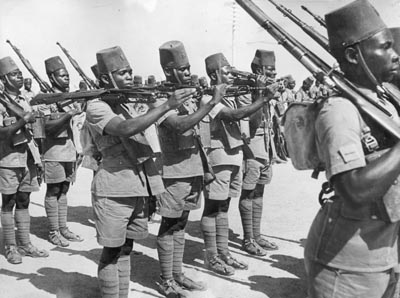 (Force Publique troops in WWII. They are armed with Mle. 89/36 rifles and wear the red fez associated with the force.)
(Force Publique troops in WWII. They are armed with Mle. 89/36 rifles and wear the red fez associated with the force.)
A secret (at the time) mission was providing security at a small uranium mine. Uranium from Belgian Congo was refined into the core of the “Little Man” A-bomb later used on Hiroshima.
A great fear of the colonial authorities was that the black members of Force Publique would take advantage of Belgium’s occupation by Germany to mutiny. This did happen by the Luluabourg company in 1944, however the revolt was suppressed by other units of Force Publique.
Force Publique suffered 496 African and 4 Belgian members killed during WWII. By early December 1944, all units were back in their barracks in Belgian Congo. One side effect of the war was an infusion of modern British equipment.
 (This was the medal awarded to African members of FP for WWII service. The medal did not come with any sort of pay bonus or rank advancement.)
(This was the medal awarded to African members of FP for WWII service. The medal did not come with any sort of pay bonus or rank advancement.)
WWII equipment used by Force Publique after 1945
Firearms – Rifles
The Mle. 1889
This was the oldest rifle used by Force Publique in the post-WWII era. It had been the main infantry weapon of the Belgian army during WWI. In the 1920s, it replaced 19th century-vintage muskets in FP use.  The Mle. 1889 used the Mauser bolt action. It fired the 7.65x53mm Belgian cartridge from a charger strip-loaded internal five-round magazine. This cartridge had a relatively low (1999fps) muzzle velocity, but had good stopping power both on the battlefield and against jungle animals. It was 4’2″ long and weighed about 9 lbs. The long 10″ WWI-style Belgian bayonet could be fitted.
The Mle. 1889 used the Mauser bolt action. It fired the 7.65x53mm Belgian cartridge from a charger strip-loaded internal five-round magazine. This cartridge had a relatively low (1999fps) muzzle velocity, but had good stopping power both on the battlefield and against jungle animals. It was 4’2″ long and weighed about 9 lbs. The long 10″ WWI-style Belgian bayonet could be fitted.
The Mle. 1889 was decently regarded in Europe during WWI but by the mid-1940s, was not liked in the Belgian Congo. The steel barrel jacket condensated jungle humidity during firing, accelerating rust. In the equatorial sun, it also acted like a reverse heat sink, accumulating heat so that the barrel was already warm even before combat.
The Belgians had already started to phase out the Mle. 1889 with Force Publique at the end of the 1930s, but WWII meant that this process was interrupted. FP companies which did not deploy abroad during the war sometimes kept theirs, and even in the late 1940s, this elderly rifle was still in use. It was finally eliminated around 1949-1950.
The FN Mle. 89/36
This was the main weapon of Force Publique during and after WWII, and has come to be regarded as “the” firearm most associated with Congo before it’s independence.  The Mle. 89/36 was basically a major redesign of the Mle. 1889 done by FN Herstal before WWII. It entered service in 1935 and was the Belgian army’s main rifle when the country was occupied in 1940. In 1938-1939, the Belgians began issuing them to Force Publique units as well.
The Mle. 89/36 was basically a major redesign of the Mle. 1889 done by FN Herstal before WWII. It entered service in 1935 and was the Belgian army’s main rifle when the country was occupied in 1940. In 1938-1939, the Belgians began issuing them to Force Publique units as well. 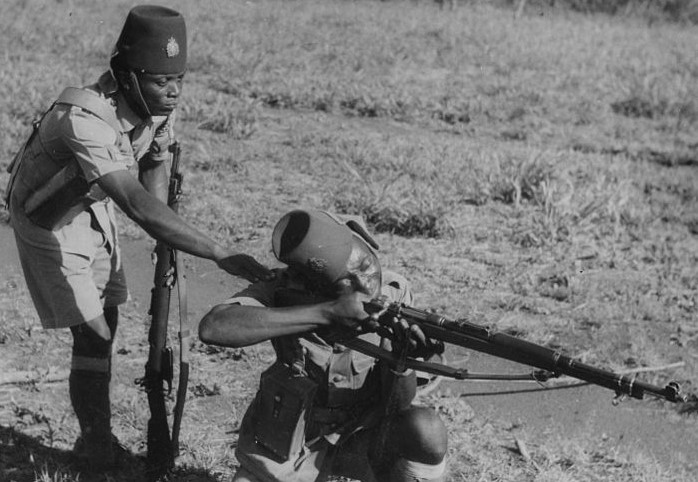 The Mle. 89/36 fired the existing Mle. 1889 ammunition, but was much shorter and lighter. The barrel jacket was eliminated. It used a reliable mauser-style bolt action and had a five-round internal magazine. The M1924 bayonet was standard. The internal magazine could be loaded by a stripper, or, dropped out and hand-loaded by individual cartridges.
The Mle. 89/36 fired the existing Mle. 1889 ammunition, but was much shorter and lighter. The barrel jacket was eliminated. It used a reliable mauser-style bolt action and had a five-round internal magazine. The M1924 bayonet was standard. The internal magazine could be loaded by a stripper, or, dropped out and hand-loaded by individual cartridges.
 (National Rifle Association diagram)
(National Rifle Association diagram)
This rifle was accurate out to about 2000 yards, although the low training given to FP’s African troops probably degraded that somewhat. All in all, this was a very well-built gun by pre-WWII standards. The war had shown self-loaders like the M1 Garand superior to bolt-action rifles, and by 1945 the non-spitzer bullet of this rifle’s cartridge was obsolete. (There was a newer round, Cartouche M1935, which had a full metal jacket spitzer bullet with muzzle velocity of 2378fps – however, only limited numbers of these reached the Belgian Congo.)  None the less, Belgium wanted to invest as little as possible in arming Force Publique, so this rifle remained the force’s firearm throughout the rest of the 1940s and much of the 1950s. In 1958, modern FN FAL assault rifles began to replace it, however this was never completed before Belgian Congo became independent and the Mle. 89/36 remained in use until the very end, and even past the colonial era in the Congolese/Zairian army.
None the less, Belgium wanted to invest as little as possible in arming Force Publique, so this rifle remained the force’s firearm throughout the rest of the 1940s and much of the 1950s. In 1958, modern FN FAL assault rifles began to replace it, however this was never completed before Belgian Congo became independent and the Mle. 89/36 remained in use until the very end, and even past the colonial era in the Congolese/Zairian army.
 (Force Publique troops on parade in 1958, with a mixture of modern FN FAL and WWII-era Mle. 89/36 rifles.)
(Force Publique troops on parade in 1958, with a mixture of modern FN FAL and WWII-era Mle. 89/36 rifles.)
The Mle. 1924(C)
This rather unique bolt-action rifle was designed with one purpose in mind; to provide Force Publique with a training rifle as absolutely cheaply as possible.  Manufactured by FN Herstal, this was a modification of the version issued to the Belgian army and police departments. It used part of other FN Herstal guns and was rechambered for civilian .22LR rimfire ammunition. It had the magazine disabled, making it a single-shot weapon. The rear sight was set to 200 meters (218 yards) maximum. Force Publique designated these weapons as “Fusil d’Entrainement” (training rifles) and only about 300 were issued to FP.
Manufactured by FN Herstal, this was a modification of the version issued to the Belgian army and police departments. It used part of other FN Herstal guns and was rechambered for civilian .22LR rimfire ammunition. It had the magazine disabled, making it a single-shot weapon. The rear sight was set to 200 meters (218 yards) maximum. Force Publique designated these weapons as “Fusil d’Entrainement” (training rifles) and only about 300 were issued to FP.
Firearms – Handguns
Before the 1950s, handguns were only issued to white officers. Thereafter they were sometimes issued to black NCOs, but rarely.
The Mle.1903
This was the oldest handgun still in FP service after WWII. Dating to the First World War, it fired the 9x20mmSR Browning Long cartridge from a seven-round box magazine. The Belgians sent a small number of these guns to the Belgian Congo as their army equipped with more modern weapons before WWII. Force Publique phased these guns out in the 1950s. 
The FN GP-35
This was the standard sidearm of the Belgian army in WWII, and was also in Force Publique use at the time. After the war, the “Browning Hi-Power” gradually became the only handgun in FP service. 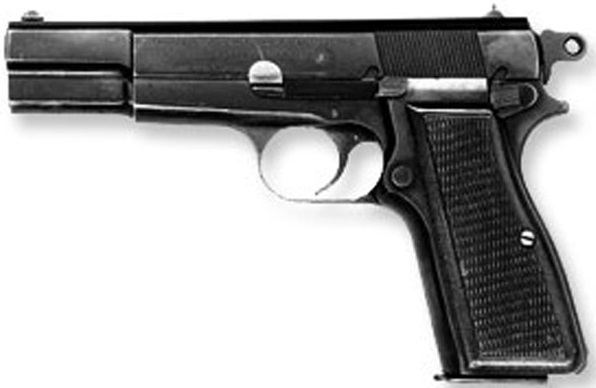 Manufactured by FN Herstal, the GP-35 fired 9mm Parabellum ammunition from a thirteen-round magazine. It was a single-action semi-automatic gun, effective to about 50 yards. The GP-35 was in Force Publique use from the early 1940s all the way until Congo became independent. Thereafter, the Congolese/Zairian army continued to use the type all the way into the 1990s.
Manufactured by FN Herstal, the GP-35 fired 9mm Parabellum ammunition from a thirteen-round magazine. It was a single-action semi-automatic gun, effective to about 50 yards. The GP-35 was in Force Publique use from the early 1940s all the way until Congo became independent. Thereafter, the Congolese/Zairian army continued to use the type all the way into the 1990s.
Artillery
The St. Chamond
This 75mm French-made field gun dated to WWI, where it was already obsolete. In the 1920s the Belgians shipped several batteries’ worth to the Belgian Congo, where they formed Force Publique’s main artillery asset during WWII and shortly thereafter. 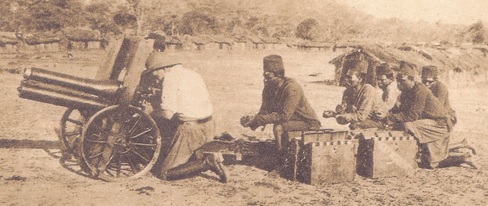 This gun had a range of about 9,000 yards. It could be broken down into pieces and carried by two or three mules, or, towed by one mule. It was not suitable for motorized towing due to the flimsy carriage.
This gun had a range of about 9,000 yards. It could be broken down into pieces and carried by two or three mules, or, towed by one mule. It was not suitable for motorized towing due to the flimsy carriage. 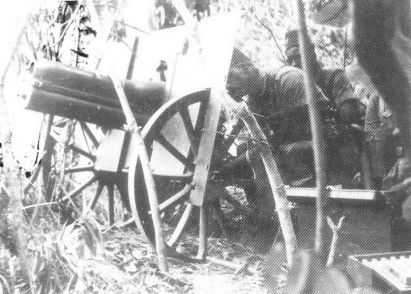 After WWII, Force Publique continued to use these guns up until about 1949-1950.
After WWII, Force Publique continued to use these guns up until about 1949-1950.
The Mle.1897 Soixante-Quinze (modifie 1938)
This 75mm field gun was heavily used by both France and Belgium during both world wars. The version Force Publique used, the modifie 1938, had a new carriage with pneumatic tires for motorized towing. The Schneider-made gun remained the same. A circular steel ground plate allowed the gun to be swiveled in bearing.
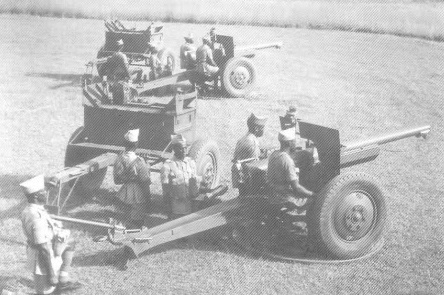 (Force Publique soldiers with modifie 1938 guns in the mid-1950s. This was when the khaki garrison cap began to be issued to African members in place of the red fez.)
(Force Publique soldiers with modifie 1938 guns in the mid-1950s. This was when the khaki garrison cap began to be issued to African members in place of the red fez.)
This gun had a maximum range of 9,350 yards with an effective range of about 7,500 yards. It weighed about 1 ½ tons and had a six-man crew. It was a surprisingly effective artillery piece and was used by Force Publique all the way up to Congo’s independence.
The QF 25-Pounder Mk.II
This was the most modern artillery piece in Force Publique’s inventory. A small number of these guns were transferred by the British during WWII, to equip Force Publique units fighting the Italians in Ethiopia.
 (Force Publique firing WWII-veteran 25-Pounders in 1952.)
(Force Publique firing WWII-veteran 25-Pounders in 1952.)
This was one of the best artillery pieces of WWII, and was used by the Allies in every theatre. It used separate ammunition (propellant cartridge and 25 lb shell were not connected). It had a range of 13,400 yards and was operated by a six-man crew. This excellent gun is probably superior to anything Belgium itself would have provided to Force Publique had WWII not happened. FP’s 25-Pounders remained in use up until Congo’s independence and then afterwards with the Congolese/Zairian army.
Anti-Aircraft defenses
The Mk.III
A number of these Bofors-designed 40mm short-range anti-aircraft guns were supplied by the British during WWII. They remained in use up until Congo’s independence. 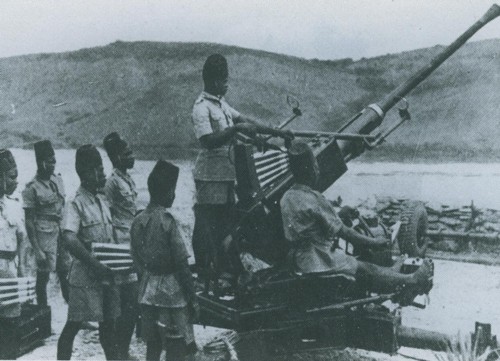 This clip-fed gun had a range of about 3 miles against low-flying aircraft.
This clip-fed gun had a range of about 3 miles against low-flying aircraft.
The Vickers QF 3.7″
These heavy AA guns were supplied by the British during WWII. Like the 25-Pounder artillery pieces, they were probably superior to anything Belgium would have supplied, had WWII not happened.
 (A Force Publique Vickers 3.7″ anti-aircraft team in 1952. They are wearing Mk.II Tommy helmets, supplied by Britain during WWII.)
(A Force Publique Vickers 3.7″ anti-aircraft team in 1952. They are wearing Mk.II Tommy helmets, supplied by Britain during WWII.)
It’s thought that only four of these guns were supplied, defending the city of Matadi. This city sits on the Congo River and is the furthest inland point that ships can proceed up the river. It was also the terminus of the Belgian Congo railroad network. These guns could, in theory, hit targets up to 39,000′ however considering the crew skill levels 30,000′ or below is more realistic. During WWII, heavy AA guns such as this worked well in large numbers, against propeller-powered bombers flying straight and level. It’s doubtful that four individual guns could have accomplished much against postwar strike jets. Force Publique had no radars so there would have been no early warning of any air raid.
Motor Vehicles
The M8 Greyhound
This widely-used armored car of WWII was Force Publique’s only armored asset it’s entire existence. Armed with a 37mm gun and a M2HB Browning .50cal machine gun, a significant number of US Army examples were transferred to Belgium after Germany’s surrender in 1945. The Belgians later shipped a few to the Belgian Congo. Two small squadrons, both belonging to an independent (the 4th) brigade of FP, were formed with Greyhounds and M38 jeeps.
 (Force Publique Greyhounds in 1952.)
(Force Publique Greyhounds in 1952.)
The M8 had a top speed of 56mph on the highway and (for a wheeled vehicle) decent off-road performance.
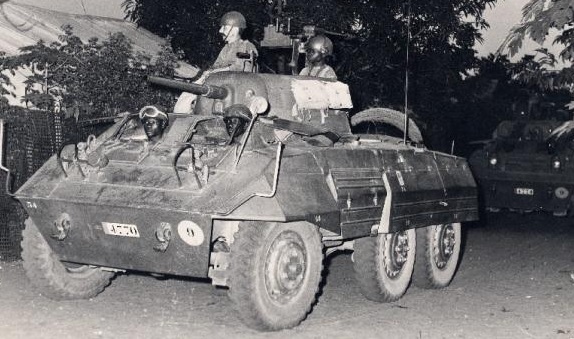 (A Force Publique M8 Greyhound of FP’s 4th Independent Brigade in Leopoldville (today Kinshasa) in January 1959.)
(A Force Publique M8 Greyhound of FP’s 4th Independent Brigade in Leopoldville (today Kinshasa) in January 1959.)
As Belgium’s control over the colony started to deteriorate, the Greyhounds were used for “MROP” missions, a French acronym meaning “establishing and maintaining public order”. These WWII-veteran armored cars were well-liked in the Belgian Congo as they were easy to maintain and operate. All remained in use up until Congo’s independence and beyond.
The M38 jeep
WWII-surplus jeeps, donated by the US Army to Belgium, were also used in the Belgian Congo by Force Publique.
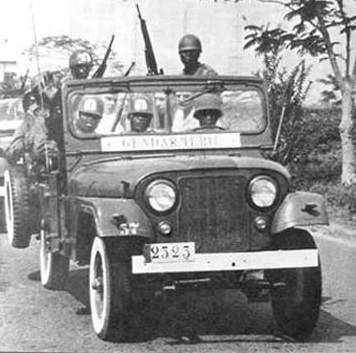 (M38 jeep of Force Publique during the 1960 independence transition.)
(M38 jeep of Force Publique during the 1960 independence transition.)
The G506
Manufactured by General Motors, the G506 was one of the US Army’s “nameless” truck designs during WWII. It was powered by an inline-six Chevrolet gasoline engine. It had a 1 ½ ton capacity.
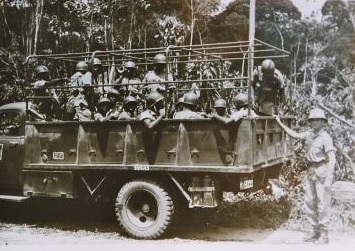 (A WWII-veteran G506 of Force Publique in the mid-1950s.)
(A WWII-veteran G506 of Force Publique in the mid-1950s.)
The US Army used this truck of course, but a good number were also supplied to Great Britain under Lend-Lease. It’s unclear if Force Publique’s G506s came from the UK during the war, or US Army transfers to Belgium afterwards. The African soldiers of FP simply called the G506 “les camion Chevrolet” (the Chevrolet truck). After WWII, they were the FP’s main truck asset up into the mid-1950s.
Aircraft
The first airplanes operated by FP were a pair of Fokker F.VIIs of Sabena airlines, which had been in transit when Belgium was occupied. Alongside these two planes was an elderly de Haviland Tiger Moth brought out of retirement in 1940. They were not used after the war.
The Stampe SV-4B
This two-seat biplane trainer was in service with the Belgian air force during WWII. 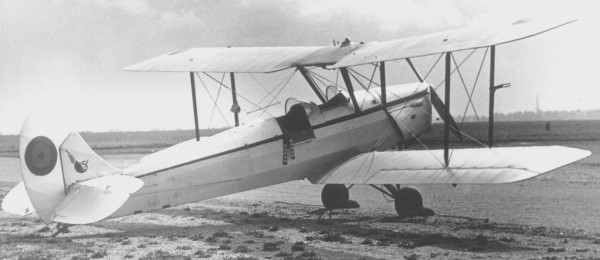 Incredibly, a handful of these planes ended up in the Belgian Congo in 1940. They had fled eastward from the oncoming Germans, then south into France when Belgium fell, then across the Mediterranean to French Algeria when France surrendered, and made their way down Africa to the Belgian Congo. Force Publique used these planes as daylight reconnaissance aircraft during WWII. As they were easy to maintain and fly, it was decided to retain them after WWII. They remained in use into the early 1950s.
Incredibly, a handful of these planes ended up in the Belgian Congo in 1940. They had fled eastward from the oncoming Germans, then south into France when Belgium fell, then across the Mediterranean to French Algeria when France surrendered, and made their way down Africa to the Belgian Congo. Force Publique used these planes as daylight reconnaissance aircraft during WWII. As they were easy to maintain and fly, it was decided to retain them after WWII. They remained in use into the early 1950s.
The Airspeed Oxford C.1
This was a bomber crew trainer of the Royal Air Force during WWII. It had a top speed of 167kts. As designed, it could carry a few light bombs however the Force Publique planes had the bomb bays deactivated.  In April 1944, the RAF donated six of these planes to Force Publique. The first trained Belgian pilots were ready in July of that year. They were based at Leopoldville. They were not used as trainers but rather as staff transports, replacing the two ex-airliners. One was modified as a cropduster to keep the colony’s economy going, and another was modified as a reconnaissance plane. They remained in use until the summer of 1955.
In April 1944, the RAF donated six of these planes to Force Publique. The first trained Belgian pilots were ready in July of that year. They were based at Leopoldville. They were not used as trainers but rather as staff transports, replacing the two ex-airliners. One was modified as a cropduster to keep the colony’s economy going, and another was modified as a reconnaissance plane. They remained in use until the summer of 1955.
Helmets
The red fez was the most identifiable icon of Force Publique. Before WWII, it was the only headwear issued to African members. After WWII, it remained the standard for both the non-combat service, and full dress, uniforms, until the early 1950s when khaki garrison caps were issued to the African troops. The fez remained the proper headgear for the black soldier’s full dress uniform all the way up until Congo’s independence.
 (Force Publique soldier’s appearance in the immediate post-WWII years; red fez with khaki neckcloth and a Mle. 89/36 rifle.)
(Force Publique soldier’s appearance in the immediate post-WWII years; red fez with khaki neckcloth and a Mle. 89/36 rifle.)
Before WWII, no helmets at all were issued to black soldiers. The European officers during WWII wore the French-made Adrian, with the Belgian lion crest added. 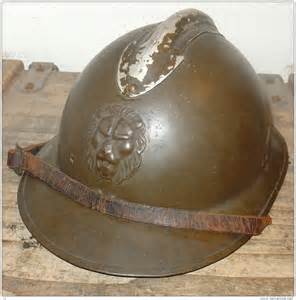 These were phased out of FP use during the first post-WWII years and were gone by 1949-1950. During WWII, Force Publique units operating for the British were issued Tommy Mk.II helmets. These remained in use until the end of the 1950s, often alongside the later M1 pot.
These were phased out of FP use during the first post-WWII years and were gone by 1949-1950. During WWII, Force Publique units operating for the British were issued Tommy Mk.II helmets. These remained in use until the end of the 1950s, often alongside the later M1 pot. 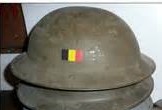 After Belgium joined NATO in 1949, it standardized on the American-made M1 pot helmet of WWII fame. After a few years, these began to trickle down to the Belgian Congo as well. In Force Publique use, the M1 was designated “Casque Mle.51”.
After Belgium joined NATO in 1949, it standardized on the American-made M1 pot helmet of WWII fame. After a few years, these began to trickle down to the Belgian Congo as well. In Force Publique use, the M1 was designated “Casque Mle.51”.  The M1 pot remained the standard helmet of Force Publique’s existence. It in turn went on to become the standard helmet of the Congolese/Zairian armies; a position it held for the remainder of the 20th century.
The M1 pot remained the standard helmet of Force Publique’s existence. It in turn went on to become the standard helmet of the Congolese/Zairian armies; a position it held for the remainder of the 20th century.
The end of Force Publique
France and Great Britain gave independence to many of their worldwide colonies in the 1950s. However Belgium remained determined to hold onto the Belgian Congo. Throughout the spring of 1959, anti-Belgian riots broke out all over the colony, resulting in the deaths of 49 Belgians and about 500 Africans. The riots were suppressed by Force Publique, however many of FP’s black soldiers were at least partially sympathetic to the rioters. In 1960, a conference was held between the Belgian government and pro-independence activists.
The conference could not have gone worse. Belgium envisioned a long, protracted period of the colony gaining independence, (sometime in the 1980s). Meanwhile the Congolese wanted immediate independence – as in literally, that minute. The conference ended with a sloppy, poorly-planned timetable of independence in one month.
For Force Publique, which was now to become the Congo army, this was a disaster. There were no black soldiers above the rank of NCO, and none at all with technical training. An emergency training effort was started however by the date of independence (30 June 1960) there was still zero black officers and only twenty cadets in training. The size of the force itself was too small; about 26,000 men would now have to defend a sovereign nation the size of western Europe.
The end of Belgian rule on 30 June 1960 was a fiasco. It had been planned that for a period of several years at least, Belgian officers and senior NCOs would stay on until sufficient Congolese could be trained.
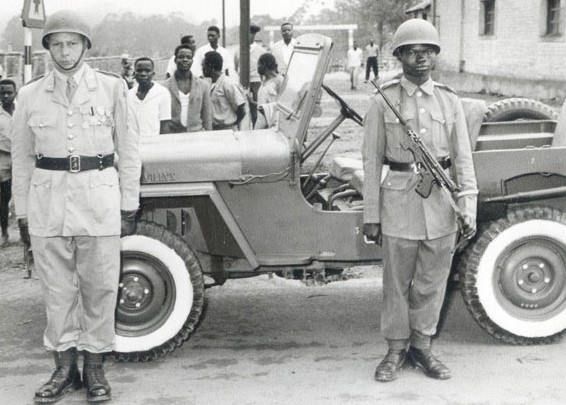 (Force Publique at the 30 June 1960 independence day celebration. Both are wearing WWII-vintage M1 pot helmets. The Congolese soldier is carrying a postwar Vigneron. This Cold War-era 9mm submachine gun is little known by today’s firearm enthusiasts but was actually a good gun. It was designed expressly for overseas Belgian use, and was cheap but effective.)
(Force Publique at the 30 June 1960 independence day celebration. Both are wearing WWII-vintage M1 pot helmets. The Congolese soldier is carrying a postwar Vigneron. This Cold War-era 9mm submachine gun is little known by today’s firearm enthusiasts but was actually a good gun. It was designed expressly for overseas Belgian use, and was cheap but effective.)
The chalkboard incident and 1960 FP mutiny
Six days after Congo became independent, the final white Force Publique commander Gen. Emile Janssens called together the most senior Congolese members of the force. He gave a speech which, while well-intentioned as praise, was delivered in an extremely arrogant and condescending way. On a chalkboard, Janssens wrote “before independence = after independence”. The Congolese had assumed that their country’s freedom would result in them being promoted, and being treated with more respect. Janssens’s speech, which implied no promotions and no new respect, infuriated them.
A spate of riots and mutiny followed, where Congolese troops turned first against their white officers and then against any white people they found. The result was a mass exodus of Europeans, crippling the new country’s economy in it’s first month of life.
Janssens was fired by the Congolese government and replaced by a black soldier who was promoted directly from enlisted sergeant to commissioned general. Belgium decided it was time to walk away from the whole mess and by August 1960, all European members of Force Publique had left. This left the force leaderless and totally lacking in technical and logistics specialists. Later that year, the force’s name was changed to Congolese Army and Force Publique’s history came to an end.
The legacy
The chaotic transition from Force Publique to the Congo / Zaire army was a crippling blow that was never really recovered from. Throughout the 1960s “Congo Crisis” years, all the way up until the fall of Mobutu in May 1997, the army suffered from poor leadership and poor planning. A good deal of ex-Force Publique WWII-vintage weaponry continued in use with Congo/Zaire. Most visible was the M1 helmets and the M8 Greyhound armored cars.
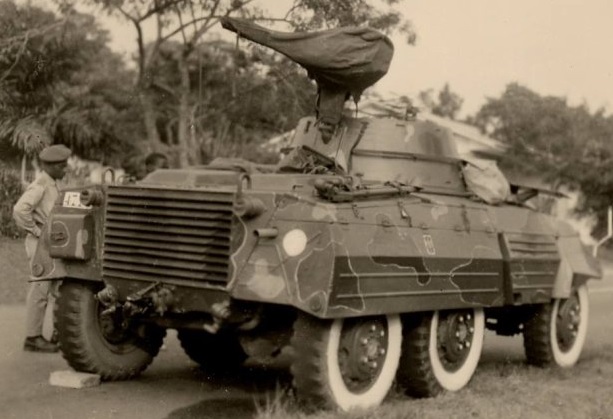 (A WWII-vintage ex-Force Publique Greyhound in use by Congo in 1963.)
(A WWII-vintage ex-Force Publique Greyhound in use by Congo in 1963.)
(In 1964, part of the Congolese army in the country’s east launched a failed rebellion. These troops were armed with WWII-vintage Mle.89/36 rifles left over from Force Publique.)


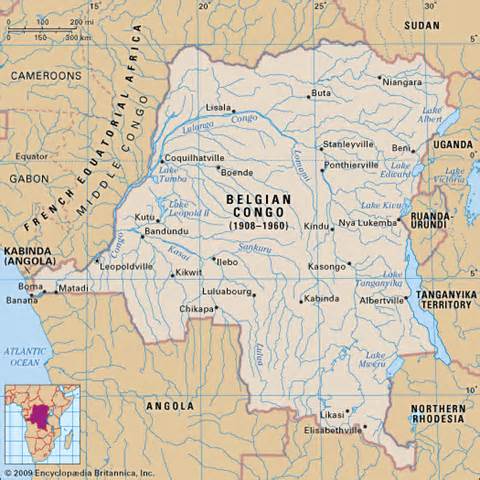
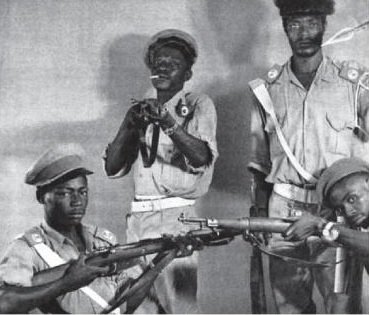
Reblogged this on Brittius.
LikeLike
[…] Force Publique in World War II (front) (source) […]
LikeLike
As I am interested in the FN1903 I do anxiously like to know were you found the information about the use of the pistol by the Force Publique. Can anybody give some information? Thanks
LikeLike